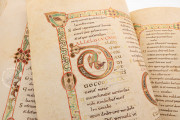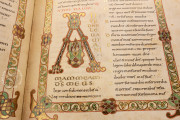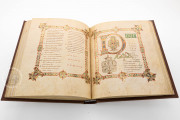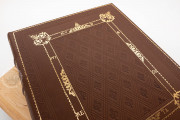This elaborate Carolingian Psalter was made at the Abbey of Saint-Bertin near Saint-Omer in northwestern France in the mid-ninth century. It is traditionally associated with Louis the German, grandson of Charlemagne and ruler of the Eastern Empire including much of modern-day Germany, and is also known as Ludwigspsalter. Its 120 parchment folios contain a complete Psalter with additional hymns, litanies, and a prayer to the Holy Cross preceding a late-ninth century full-page Crucifixion with donor portrait.
The text of the Psalms is arranged in two columns of Caroline minuscule. Each Psalm begins with a large initial decorated with interlace and occasionally zoomorphic forms. These are then surrounded by frames composed of complex geometric patterns, interlace, and animal head terminals. The main colors used are bright green, pale yellow, and dark red with liberal use of gold. This lustrous and elegant manuscript is a fine example of mature Carolingian illumination.
Square Pages with Elaborate Initials
The Psalter of Louis the German is unusual for its nearly square pages, giving it a stately appearance. Every page of the Psalms is framed. Each two-page spread features a matching design, which changes throughout the manuscript.
Within the frame, the Caroline minuscule text is arranged in two columns with each Psalm introduced with rubricated uncial titling and a large ornamental initial. Major divisions in the Psalms are more elaborate, especially the first Psalm where the entire page is devoted to the opening words "Beatus vir".
Crucifixion with Royal Portrait
The only figural illustration is on fol. 120v, a full-page crucifixion that was added to the psalter at the end of the ninth century at Lorsch Abbey. The central figure of Christ on the Cross is flanked by Mary and John with personifications of the sun and moon overhead. The bearded Jesus wears a purple loincloth and looks at Mary, who in turn looks across to John, who looks gazes out from the page and gestures to Jesus. Below, a man in a decorated purple tunic grasps the cross where it narrows above the ground. This serves as a donor portrait and a now-erased label identifies him as Arnulf of Carinthia, the grandson of Louis the German.
Carolingian Adaptation of Insular Calligraphy
The decorative initials feature fine interlace as terminals and filling elements in the Insular tradition introduced to the Continent in works such as the eighth-century Echternach Gospels (Paris, Bibliothèque Nationale, MS lat. 9389) and are similar to contemporary manuscripts in Lorsch like the Echternach Evangelary (Vatican, Biblioteca Apostolica Vaticana, Pal. lat. 46).
The Psalter of Louis the German was not in the Bibliotheca Palatina formed after the dissolution of the monasteries but rather was in Rellingausen for a time. By 1736 it was in the Prussian royal library.
Binding description
The current binding is post-1600 of full brown leather with blind tooling and an ornate filigree gilt panel surrounded by tooled lozenge diapering.
We have 1 facsimile edition of the manuscript "Psalter of King Louis": Psalter Ludwigs des Deutschen facsimile edition, published by Akademische Druck- u. Verlagsanstalt (ADEVA), 2021
Request Info / Price

























